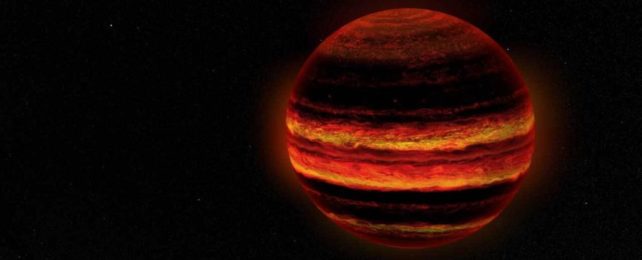New observations from the James Webb Space Telescope have given us direct confirmation that some alien worlds have clouds of rock.
The telescope has directly detected silicate clouds in the atmosphere of a brown dwarf – the first time, according to an international team of astronomers, that such a detection has been made in a planetary-mass companion outside the Solar System.
The complete findings, the team says, constitute the best spectrum yet for a planetary mass-object. These results could not only help us better understand these so-called 'failed stars', but represent just a foretaste of what the JWST can do.
The paper has been submitted to AAS journals, and is available on preprint server arXiv while it undergoes the peer review and publication process.
We've already seen JWST take a direct image of an exoplanet, but a brown dwarf is a slightly different kettle of fish.
These objects are what happens when a baby star doesn't accumulate enough mass to kickstart hydrogen fusion in its core, and they occupy the mass regime between the chonkiest planets and the weeniest stars.
However, at around 13.6 times the mass of Jupiter (sorry, Jupiter, you tried), brown dwarfs can fuse deuterium, or heavy hydrogen – hydrogen with a proton and a neutron in the nucleus, instead of just a single proton.
The fusion pressure and temperature of deuterium are lower than that of hydrogen, which means brown dwarfs are kind of like stars 'lite'.
This means that, unlike exoplanets, brown dwarfs emit their own heat and light. It's much less than that of stars, obviously, but we can detect it directly, especially in the infrared wavelengths in which JWST specializes.
The observations obtained by a team led by astronomer Brittany Miles of the University of California of Santa Cruz are from a brown dwarf some 72 light-years away called VHS 1256-1257 b, first described in 2015.
It clocks in at around 19 times the mass of Jupiter, and is relatively young, with a reddish-hued atmosphere.
This hue has previously been attributed to clouds in young brown dwarfs, so the team took infrared spectra to see if they could determine the brown dwarf's composition.
This works because different elements absorb and re-emit light at different wavelengths. Scientists can look at the spectrum to see dimmer and brighter features, and determine the elements that cause them.
The atmospheric composition of VHS 1256-1257 b was similar, the team found, to other brown dwarfs studied in infrared wavelengths, but much clearer.
"Water, methane, carbon monoxide, carbon dioxide, sodium, and potassium are observed in several portions of the JWST spectrum based on comparisons from template brown dwarf spectra, molecular opacities, and atmospheric models," the researchers write in their paper.
The carbon monoxide feature, the researchers say, is the clearest seen yet. And they also detected, as they hoped, clouds – long hypothesized clouds of silicate particles in a thick layer, with a submicron grain size. These are likely minerals such as forsterite, enstatite, or quartz, the team notes.
This seems to finally confirm that young brown dwarfs can be circled by patchy silicate clouds that influence variability in brightness.
This gives us a tool for interpreting observations of brown dwarfs in the future, and something to look for in future observations, the researchers note.
"These initial results from the JWST early release science observations are groundbreaking and also obtainable for numerous other nearby brown dwarfs that will be observed in future observation cycles," they write in their paper.
"This observatory will be a trailblazer, pushing our understanding of atmospheric physics in planetary-companions, brown dwarfs, and exoplanets for years to come."
The research has been submitted to AAS journals, and is available on arXiv.
